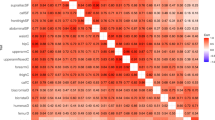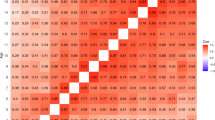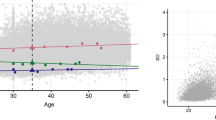Abstract
OBJECTIVE:1) To estimate the heritability of body mass index (BMI) in twins aged 16 y and 17 y, with a special emphasis on gender-specific genetic effects and 2) to compare heights, weights, BMIs, and prevalences of ‘overweight’ (BMI≥≥25 kg/m2) in these twins and in singletons aged 16.5 y.
DESIGN:Cross-sectional and longitudinal epidemiological questionnaire study of twins at ages 16 y and 17 y, and cross-sectional study of singletons at age 16.5 y.
MEASUREMENTS:BMI (kg/m2) was calculated from self-reported heights (m) and weights (kg).
SUBJECTS:4884 twins (2299 boys, 2585 girls) at baseline (age 16 y), 4401 twins (2002 boys, 2399 girls) at age 17 y, and 2509 singletons (1147 boys, 1362 girls) at age 16.5 y. Both twin and singleton samples are nationally representative.
RESULTS:At the ages of 16 y and 17 y, genetic effects accounted for over 80% of the interindividual variation of BMI. The correlations for male–female pairs were smaller than for either male-male or female–female dizygotic pairs. The singletons, especially the boys, had a higher BMI than the twins. Nine percent of singleton boys, but only 4–6% of twin boys and twin and singleton girls were ‘overweight’ (BMI≥≥25 kg/m2).
CONCLUSIONS:Among adolescents, genetic factors play a significant role in the causes of variation in BMI. The genetic modelling suggested that the sets of genes explaining the variation of BMI may differ in males and females. At this age, the twin boys, but not girls, seem to be leaner than singletons. Further follow-up will indicate whether these small differences disappear, and if not, what implications it might have to the generalizability of twin studies.
This is a preview of subscription content, access via your institution
Access options
Subscribe to this journal
Receive 12 print issues and online access
$259.00 per year
only $21.58 per issue
Buy this article
- Purchase on Springer Link
- Instant access to full article PDF
Prices may be subject to local taxes which are calculated during checkout
Similar content being viewed by others

Author information
Authors and Affiliations
Rights and permissions
About this article
Cite this article
Pietiläinen, K., Kaprio, J., Rissanen, A. et al. Distribution and heritability of BMI in Finnish adolescents aged 16 y and 17 y: A study of 4884 twins and 2509 singletons. Int J Obes 23, 107–115 (1999). https://doi.org/10.1038/sj.ijo.0800767
Received:
Revised:
Accepted:
Published:
Issue Date:
DOI: https://doi.org/10.1038/sj.ijo.0800767
Keywords
This article is cited by
-
Genetics and Epigenetics in Obesity: What Do We Know so Far?
Current Obesity Reports (2023)
-
Genetic contributions to NAFLD: leveraging shared genetics to uncover systems biology
Nature Reviews Gastroenterology & Hepatology (2020)
-
The role of genetic and environmental influences on the association between childhood ADHD symptoms and BMI
International Journal of Obesity (2019)
-
Finding the missing heritability in pediatric obesity: the contribution of genome-wide complex trait analysis
International Journal of Obesity (2013)
-
Genetic and Environmental Correlations Between Body Mass Index and Waist Circumference in China: The Qingdao Adolescent Twin Study
Behavior Genetics (2013)


